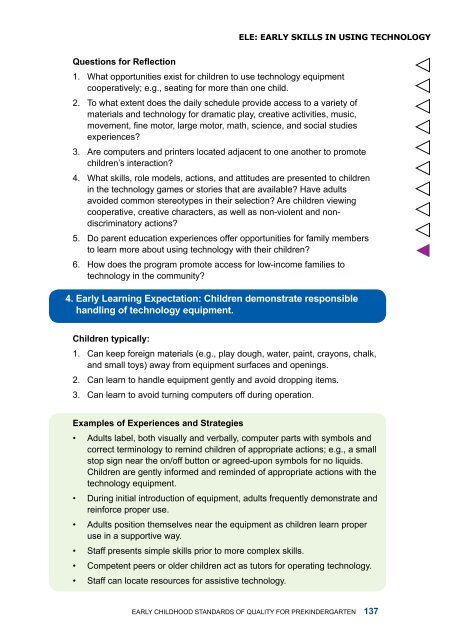Early Childhood Standards of Quality for ... - State of Michigan
Early Childhood Standards of Quality for ... - State of Michigan
Early Childhood Standards of Quality for ... - State of Michigan
Create successful ePaper yourself
Turn your PDF publications into a flip-book with our unique Google optimized e-Paper software.
ELE: EARLY SKILLS IN USING TECHNOLOGYQuestions <strong>for</strong> Reflection1. What opportunities exist <strong>for</strong> children to use technology equipmentcooperatively; e.g., seating <strong>for</strong> more than one child.2. To what extent does the daily schedule provide access to a variety <strong>of</strong>materials and technology <strong>for</strong> dramatic play, creative activities, music,movement, fine motor, large motor, math, science, and social studiesexperiences?3. Are computers and printers located adjacent to one another to promotechildren’s interaction?4. What skills, role models, actions, and attitudes are presented to childrenin the technology games or stories that are available? Have adultsavoided common stereotypes in their selection? Are children viewingcooperative, creative characters, as well as non-violent and nondiscriminatoryactions?5. Do parent education experiences <strong>of</strong>fer opportunities <strong>for</strong> family membersto learn more about using technology with their children?6. How does the program promote access <strong>for</strong> low-income families totechnology in the community?4. <strong>Early</strong> Learning Expectation: Children demonstrate responsiblehandling <strong>of</strong> technology equipment.Children typically:1. Can keep <strong>for</strong>eign materials (e.g., play dough, water, paint, crayons, chalk,and small toys) away from equipment surfaces and openings.2. Can learn to handle equipment gently and avoid dropping items.3. Can learn to avoid turning computers <strong>of</strong>f during operation.Examples <strong>of</strong> Experiences and Strategies• Adults label, both visually and verbally, computer parts with symbols andcorrect terminology to remind children <strong>of</strong> appropriate actions; e.g., a smallstop sign near the on/<strong>of</strong>f button or agreed-upon symbols <strong>for</strong> no liquids.Children are gently in<strong>for</strong>med and reminded <strong>of</strong> appropriate actions with thetechnology equipment.• During initial introduction <strong>of</strong> equipment, adults frequently demonstrate andrein<strong>for</strong>ce proper use.• Adults position themselves near the equipment as children learn properuse in a supportive way.• Staff presents simple skills prior to more complex skills.• Competent peers or older children act as tutors <strong>for</strong> operating technology.• Staff can locate resources <strong>for</strong> assistive technology.<strong>Early</strong> <strong>Childhood</strong> <strong>Standards</strong> <strong>of</strong> <strong>Quality</strong> <strong>for</strong> Prekindergarten 137


